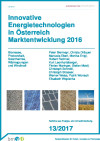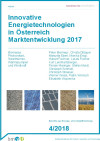Suchergebnisse
Jahresbericht 2015 des IEA Photovoltaic Power Systems Programme
Im Jahresbericht wird eine Übersicht über die laufenden Forschungsprojekte gegeben. Darüber hinaus werden relevante Entwicklungen der Mitgliedsländer vorgestellt.
Conference: Air Source Heat Pumps in Retrofitting Applications
7th May 2015
AIT Austrian Institute of Technology, Giefinggasse 21210 Vienna, AT
During the conference you will get an overview concerning the state of the art, current development in R&D, trends and perspectives in the field of air source heat pumps for retrofitting applications in urban areas.
Innovative Energietechnologien in Österreich - Marktentwicklung 2016

Biomasse, Photovoltaik, Solarthermie, Wärmepumpen und Windkraft
Schriftenreihe
13/2017
Peter Biermayr, Christa Dißauer, Manuela Eberl, Monika Enigl, Hubert Fechner, Kurt Leonhartsberger, Florian Maringer, Stefan Moidl, Christoph Schmidl, Christoph Strasser, Werner Weiss, Patrik Wonisch, Elisabeth Wopienka
Herausgeber: BMVIT
Deutsch, 242 Seiten
Downloads zur Publikation
IEA-4E EDNA Workshop on Efficient Electric Vehicle Supply Equipment - EVSE
28. September 2017
BENE Idea Lab, Neutorgasse 4-8, 1010 Vienna
In 2016 more than 2 million electric cars were on the road globally, with over 750 thousand units sold over the year. Substantial new implementation of electric vehicle supply equipment (EVSE) was also observed on par with the growth of the global electric car stock.
IEA Bioenergy Task 32: Aerosols from Biomass Combustion - Technical report

Umfassender Bericht zum Stand des Wissens zu Emissionen aus Biomasse Verbrennung und möglichen gesundheitlichen Auswirkungen. Empfehlungen für den richtigen Einsatz von Biomasse Verbrennung im zukünftigen Energiesystem.
T. Nussbaumer
Herausgeber: IEA Bioenergy Task32
Englisch, 32 Seiten
Downloads zur Publikation
Innovative Energietechnologien in Österreich - Marktentwicklung 2017

Biomasse, Photovoltaik, Solarthermie, Wärmepumpen und Windkraft
Schriftenreihe
4/2018
Peter Biermayr, Christa Dißauer, Manuela Eberl, et al.
Herausgeber: BMVIT
Deutsch, 257 Seiten
Downloads zur Publikation
IEA Bioenergy Task 42 - Nationales Vernetzungstreffen
22. November 2018
Universität für Bodenkultur Wien, Gregor-Mendel-Straße 33, 1180 Wien, AT
Thematischer Schwerpunkt des nationalen Vernetzungstreffen der Bioraffinerie-AkteurInnen in Österreich lag diesjährig im Bereich Holz, Zellstoff und Papier-Bioraffinerien.
Symposium "Monitoring und Steuerung im Energieinnovationssystem"
17. Juni 2019
BMVIT, Radetzkystraße 2, Raum EA08, 1030 Wien
Erfolge und Hemmnisse einer erfolgreichen Innovationskette wurden aufgezeigt und mit VertreterInnen aus Wirtschaft und Wissenschaft diskutiert.
IEA PVPS Task 13: Review on Infrared and Electroluminescence Imaging for PV Field Applications (2018)

Die bildgebenden Verfahren der Infrarot-Thermografie und Elektrolumineszenz werden für Anwendungen im Feld vorgestellt.
Ulrike Jahn, Magnus Herz, Marc Köntges, David Parlevliet, Marco Paggi, Ioannis Tsanakas, Joshua S. Stein, Karl A. Berger, Samuli Ranta, Roger H. French, Mauricio Richter, Tadanori Tanahashi und Erin Ndrio, Gerhard Mathiak, Bernhard Weinreich, David Hottenrott, Justin S. Fada, Bernhard Kubicek, Claudia Buerhop-Lutz, Vasco Medici
Herausgeber: IEA PVPS Task 13 / 2018
Englisch, 99 Seiten
Downloads zur Publikation
Webinar: The past, present and future for biomass gasification
30. January 2020
Webinar - online, AT
The IEA Bioenergy Webinar Series are dedicated to various topics in the field of bioenergy. This time the past, current situation and outlook into the future of thermal gasification are discussed.
Webinar - Integration of Biogas Systems into the Energy System
21. January 2021
Online, AT
IEA Bioenergy Task 37 recently published a new report highlighting how to match biogas supply and demand for energy as electricity, heat or transport biofuel across the larger future energy system. This webinar will present the main conclusions.
IEA 4E EDNA Bericht: Total Energy Model 2.0 (TEM) für netzwerkverbundene Geräte (2021)

Der 4E Electronic Devices & Networks Annex (EDNA) untersucht Potentiale und Maßnahmen für energieeffiziente elektronische Geräte und Anwendungen. Das entwickelte Total Energy Model (TEM) simuliert den zusätzlichen globalen Energieverbrauch, der durch die Netzwerkverbindung von elektronischen Geräten entsteht. Dieses Modell wurde erweitert und steht nun in Form eines TEM2.0 zur Verfügung.
Herausgeber: IEA 4E EDNA
Englisch, 34 Seiten
Downloads zur Publikation
In-take Workshop: Solare Energie in der Stadtplanung
5. November 2015
Loff, ReininghausgründeGraz, AT
Der Workshop ist dem Thema der Integration der erneuerbaren Energie im städtischen Umfeld gewidmet. Die Thematik wird aus unterschiedlichen Perspektiven beleuchtet und diskutiert.
IEWT 2013: 8. Internationale Energiewirtschaftstagung
13. - 15. Februar 2013
TU Wien, Karlsplatz 13Wien, AT
Erneuerbare Energien: Überforderte Energiemärkte?
Energy and Climate Change - World Energy Outlook Special Report

Herausgeber: International Energy Agency (IEA), ©OECD/IEA 2015 Energy and Climate Change World Energy Outlook Special Report, IEA Publishing
Englisch, 200 Seiten
Performance and risks of advanced pulverised coal plant (Nalbandian, 05-2008)

Hermine Nalbandian
Herausgeber: IEA-CCC
Englisch, 70 Seiten
IEA HPT Annex 56: Artikel "Digitalisation and IoT for heat pumps" (2022)

In diesem Artikel werden verschiedene IoT-Aspekte von Wärmepumpen vorgestellt, die vom österreichischen Projektteam für den IEA HPT Annex 56 erarbeitet wurden.
V. Wilk, R. Jentsch, T. Barz, C. Reichl, S. Hauer, B. Windholz, S. Knöttner, R. Hemm, J. Spreitzhofer (Austrian Institute of Technology GmbH); G. Music, G. Steindl, W. Kastner (TU Wien, Institute of Computer Engineering); H. Plank, C. Heschl (University of Applied Sciences Burgenland); R. Partl, D. Ziermann, R. Stelzer (Forschung Burgenland GmbH)
Herausgeber: BFE Bundesamt für Energie, Schweiz
Englisch, 13 Seiten
Energieflexibilität als Teil eines zukünftigen dekarbonisierten Energiesystems
16. Oktober 2024, 14:00 - 17:00 Uhr
Grand Hotel Wiesler, Grieskai 4-8, 8020 Graz
Beim Seminar werden die nationalen Arbeiten und Ergebnisse am Projekt IEA EBC Annex 82 "Energie-flexible Gebäude als Teil resilienter, kohlenstoffarmer Energiesysteme" der interessierten Öffentlichkeit präsentiert.
Erster IEA-Solarthermie Newsletter "Solar Update" 2011 verfügbar
Lesen Sie alles über die neuesten Projekte und Aktivitäten des IEA-Programmes "Solares Heizen und Kühlen" und seinen Mitgliedsländern.
22nd International Conference On Fluidized Bed Conversion (FBC)
14. - 17. June 2015
Radisson Blu Marina Palace HotelTurku, FI
The 22nd FBC-Conference will cover the latest issues in fluidized bed combustion technology for power production, co-generation and waste incineration including fundamental research, equipment design, application and performance experience in pilot and demonstration plants as well as in industrial sites.
